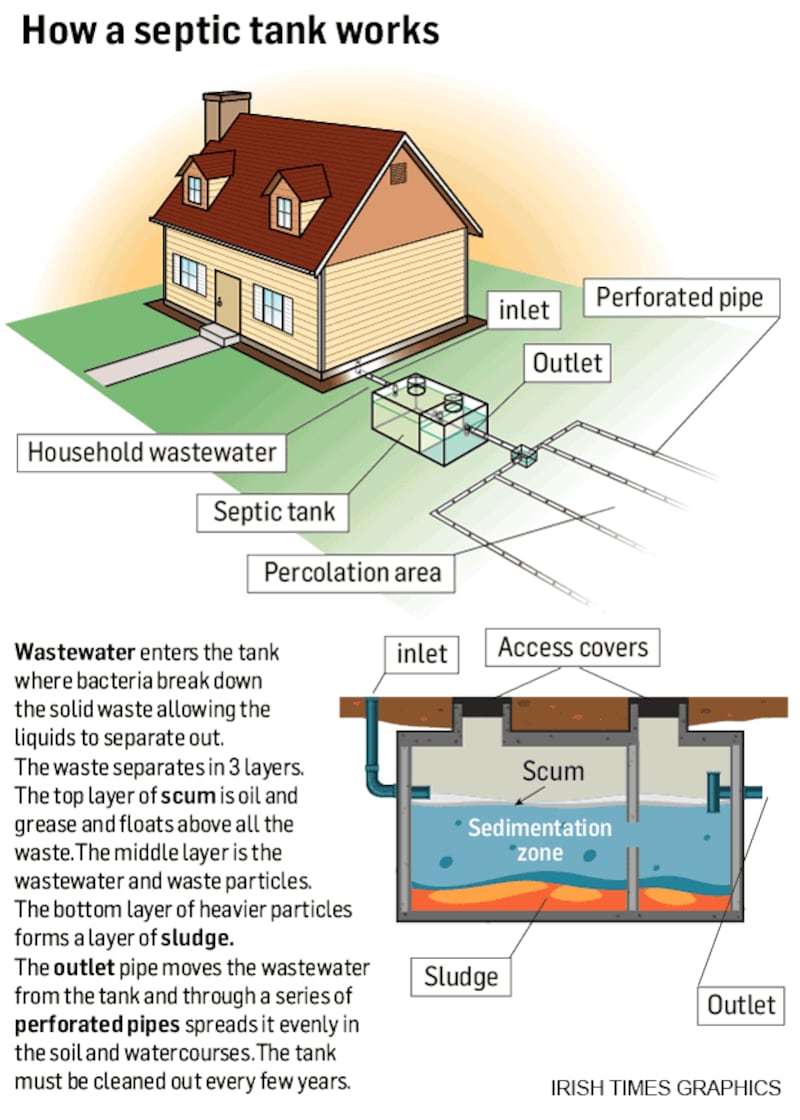Faulty septic tanks continue to pose a major public health and environmental pollution threat, with latest round of Environmental Protection Agency (EPA) inspections confirming nearly half were not operating effectively.
A review of more than 2,000 inspections of septic tanks and other domestic waste water treatment systems in 2017 and 2018 resulted in a high failure rate “because they were not built or maintained properly”.
Faulty systems can contaminate household wells and pollute rivers, the EPA warned.
Director of the EPA's office of environmental enforcement Dr Tom Ryan added: "If you do not maintain your septic tank, it can contaminate your own or your neighbour's well or your local stream, putting your health at risk and that of your family and neighbours."
Owners of septic tanks should take simple steps to maintain them “by making sure it is not leaking, ponding or discharging to ditches and by cleaning it out regularly”, he said.
The report found that nearly one-third of systems that failed inspections during 2013-2018 were still not fixed. “Local authorities need to take appropriate measures to ensure householders fix systems that fail inspection,” Dr Ryan said.
EPA senior scientist Noel Byrne said there was an onus on householders to fix systems once problems were detected.
“To improve water quality, the Government’s proposed expanded septic tank grant scheme, due to be launched later this year, will increase the maximum grant aid available to €5,000 and remove the means test requirements,” he pointed out.
Mr Byrne added there were significant risks to individuals based on the type of bacteria that could present in drinking water supplies, and the old, young, and pregnant women could be particularly exposed to bacteria like E.coli.
In addition, he said, the risks to the environment were becoming apparent through testing of rivers. Some 166 sections showed that sewage from single houses or housing developments were having an impact, including on acquaculture.
He described the 48 per cent failure rate for the inspection regime as “disappointing”. A total of 852 systems that previously failed had not yet been fixed, and of those 474 date from 2017 or earlier and therefore the issue has remained unresolved for more than a year. The efficacy of local authorities at pursuing failures and carrying out inspections also varied significantly, the EPA found.
Local authorities need to have an effective enforcement system in place to ensure householders fix systems that fail inspection, the EPA stressed.

A total of 12 cases had been taken by local authorities against individuals, although not all had been progressed to court as some individuals had completed repairs following the initiation of the enforcement action.
The county with the highest failure rate was Mayo, where 78 per cent of the 169 tanks that were inspected did not meet standards. The county was followed by Roscommon, where the failure rate was 65 per cent, and Wexford and Leitrim, where it was at 63 per cent. When it came to the rate at which failed systems were repaired, the worst offending local authority was Galway City, where just 20 per cent were fixed, followed by Leitrim at 37 per cent and Offaly at 38 per cent.
The most common reason for failure was a lack of maintenance of a tank, or an absence of desludging, followed by effluent discharging illegally into surface water, leaking, effluent ponding or rainwater entering into runoff.
EPA guidelines are ‘impeding’ home building
Architect Peter O’Rourke, who hails from Ballinagleara in Co Leitrim, says the introduction of a strict new regime on septic tanks has badly impacted the county, which suffers from poor soil quality. This has a knock on effect on the capacity of a tank to meet drainage and other standards, meaning it is very difficult to get planning permission for new builds.
“It’s gone to a new low in relation to the construction of new housing because it’s impeded by the new EPA guidelines,” he said.
“The biggest problem we have in North and Mid Leitrim is the land is very poor and we’re not able to achieve the required standards for a perculation test,” he told The Irish Times.
“If you take the process of going to build a house, the first thing we do is put them through a soil test before anything. If you don’t pass the soil test there’s no point in going further,” he said.
He estimated that up to 85 per cent of the county would not pass a perculation test. When it came to his business, he said “it’s had a huge impact; we’re lucky enough to have a few [PROJECTS]where they have passed the test or there’s a small sewerage system in operation.”
Mr O’Rourke said he had many clients who had wanted to move to the county but had been knocked back during the planning process due to the issues related to septic tanks. He said that he didn’t blame Leitrim County Council for the rejections.
“What appears to be happening, and it’s not the fault of the local authority who are restricted by the EPA code of practice - it’s coming from Europe,” he said.










